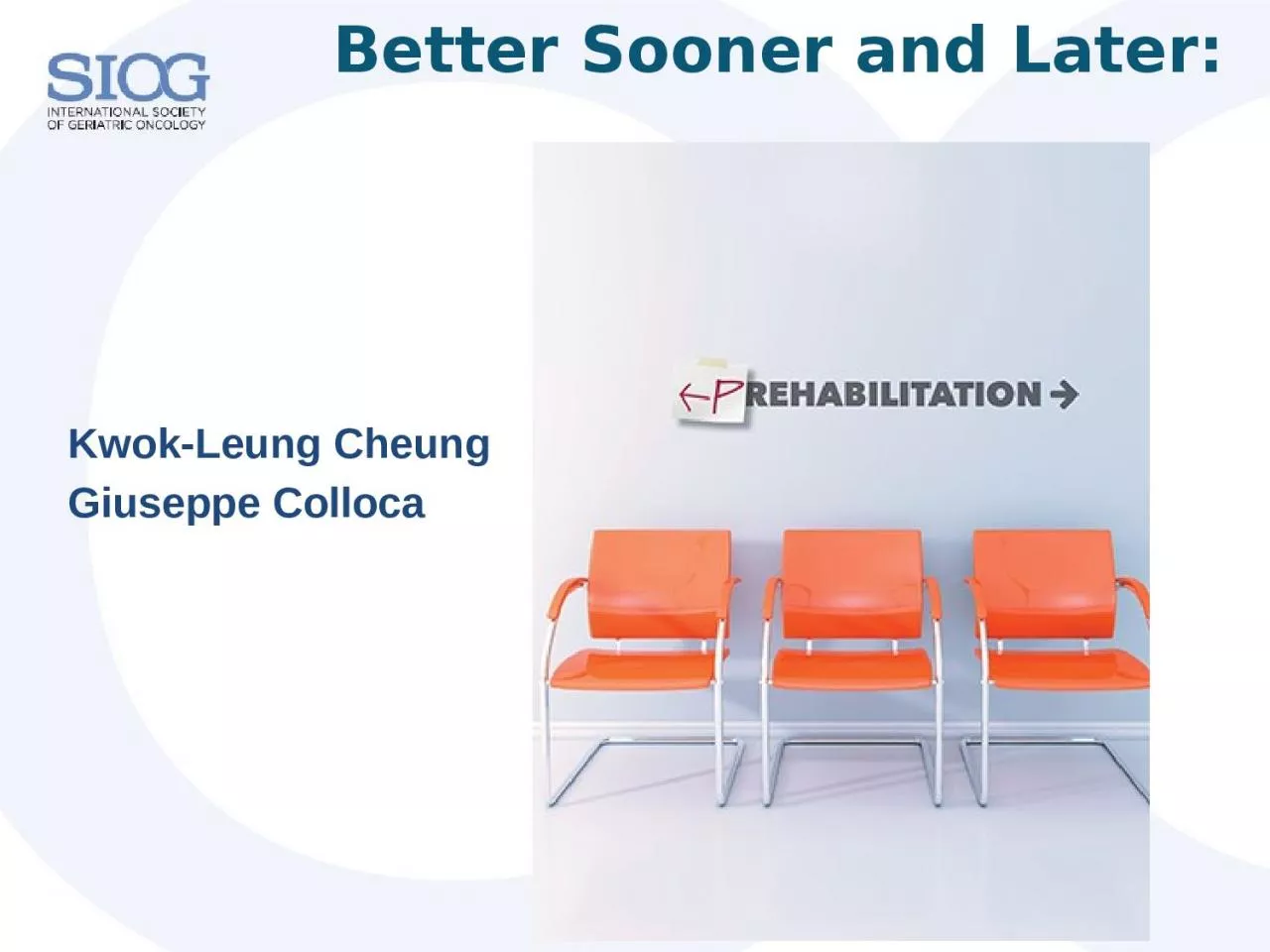

KwokLeung Cheung Giuseppe Colloca Disclosure Within the last 5 years KwokLeung Cheung has received an honorarium from Chugal received research funding from AstraZeneca served as an advisory board member for AstraZeneca and Genomic Health ID: 1040934
Download Presentation The PPT/PDF document "Better Sooner and Later:" is the property of its rightful owner. Permission is granted to download and print the materials on this web site for personal, non-commercial use only, and to display it on your personal computer provided you do not modify the materials and that you retain all copyright notices contained in the materials. By downloading content from our website, you accept the terms of this agreement.
1. Better Sooner and Later:Kwok-Leung CheungGiuseppe Colloca
2. DisclosureWithin the last 5 years, Kwok-Leung Cheung has received an honorarium from Chugal;received research funding from AstraZeneca;served as an advisory board member for AstraZeneca and Genomic Health. Giuseppe Colloca has no conflicts of interest to declare.
3. Cancer rehabilitation is defined as “medical care that should be integrated throughout the oncology care continuum and delivered by trained rehabilitation professionals who have it within their scope of practice to diagnose and treat patients’ physical, psychological and cognitive impairments in an effort to maintain or restore function, reduce symptom burden, maximize independence and improve quality of life in this medically complex population.”What is Cancer Rehabilitation?
4. Cancer rehabilitation, similar to stroke and orthopedic rehabilitation, utilizes a multidisciplinary approach to assessment and treatment that helps to:Address disease-related and treatment-related impairments;Decrease the number and/or severity of impairments and long-term problems; Minimize survivors’ distress and disability.What is Cancer Rehabilitation?
5. Rehabilitation Interventions Focused on Improving Physical Health and Decreasing Disability.
6. Interdisciplinary Rehabilitation Team Strategies
7. Interdisciplinary Rehabilitation Team Strategies
8. Impairments vs. disability
9. Examples of Functional Assessment
10. Identifying Physical Impairments in Patients With Cancer
11. Identifying Physical Impairments in Patients With Cancer
12. Identifying Physical Impairments in Patients With Cancer
13. General Physical ImpairmentsDifficulty returning to premorbid activitiesJoint pain, diffuse (e.g., arthralgias)Musculoskeletal pain (e.g., myalgias)Neuropathic painSomatic painVisceral painWeaknessFatigueDeconditioningCommon Impairments Treated
14. Functional DisabilitiesInability to return to workDifficulty caring for children/grandchildrenLimited mobility due to safety concerns (walking, driving, etc.)Inability to travel and take vacationsDifficulty with ADLs (e.g., dressing, bathing)Difficulty with IADLs (e.g., chores, shopping)
15. Cancer Rehabilitation and the Care Continuum
16. What is Cancer Prehabilitation?
17. “process on the cancer continuum of care that occurs between the time of cancer diagnosis and the beginning of acute treatment and includes physical and psychological assessments that establish a baseline functional level, identify impairments, and provide interventions that promote physical and psychological health to reduce the incidence and/or severity of future impairments.”What is Cancer Prehabilitation?
18.
19. Examples of Prehabilitation Goals▪ Improve cardiovascular, pulmonary, and/or musculoskeletal function. ▪ Improve balance and reduce the risk of falls. ▪ Reduce anxiety and improve coping with specific cognitive behavioral strategies. ▪ Improve quality of sleep with sleep hygiene education. ▪ Optimize surgical outcomes with smoking cessation interventions. ▪ Optimize diet with nutrition counseling. ▪ Begin preoperative pelvic floor muscle strengthening to improve continence outcomes. ▪ Begin pretreatment swallowing exercises to improve swallowing outcomes. ▪ Implement home safety strategies to avoid falls. ▪ Facilitate return to work with adaptive equipment.
20. 20
21.
22.
23. Prehabilitation → RehabilitationNutritionExerciseAnxietySmoking/Alcohol
24. Prehabilitation → RehabilitationSurgery in adultsCancer surgery in older adultsSingle vs multi-modality approachPrehabilitation vs rehabilitation Enhanced recovery after surgery (ERAS)
25.
26.
27. Improving the Oncology-Rehabilitation Interface ▪ Include trained rehabilitation professionals in the formal cancer care programming, ▪ Educate all staff involved in the care of oncology patients about impairment-driven cancer rehabilitation care. ▪ Establish a multidisciplinary cancer rehabilitation program/service line ▪ Use screening tools to identify impairments. ▪ Identify screening opportunities and integrate with appropriate on-site and/or local referral resources. ▪ Require documentation of the navigation process, including cancer rehabilitation referrals. ▪ Track patient functional outcomes across the continuum of care beginning with a baseline assessment. ▪ Include reassessments to identify new or ongoing rehabilitation needs. ▪ Include the patient as a partner in his/her rehabilitation care.
28.